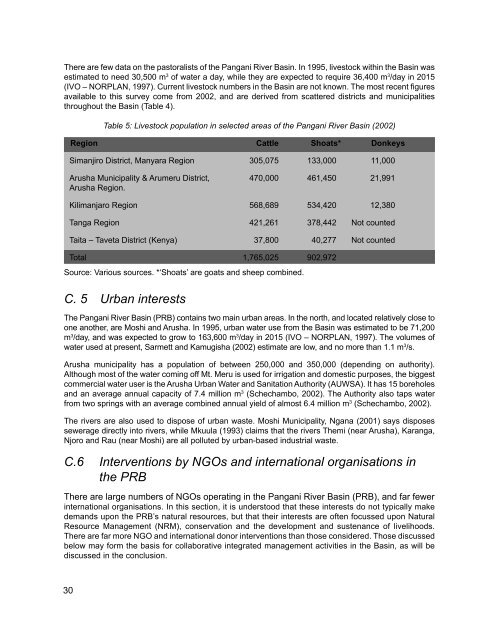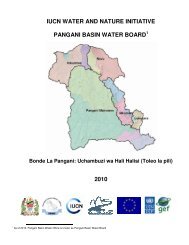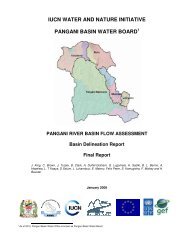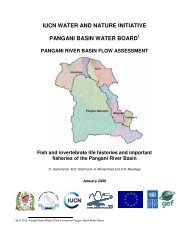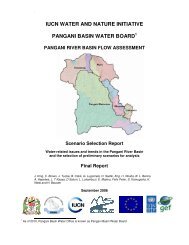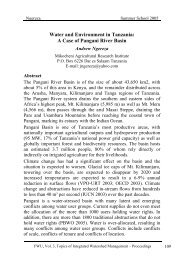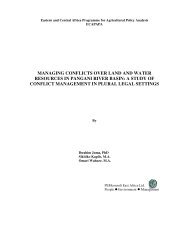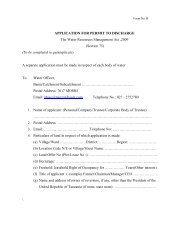PANGANI BASIN WATER BOARD
PANGANI BASIN WATER BOARD
PANGANI BASIN WATER BOARD
Create successful ePaper yourself
Turn your PDF publications into a flip-book with our unique Google optimized e-Paper software.
There are few data on the pastoralists of the Pangani River Basin. In 1995, livestock within the Basin was<br />
estimated to need 30,500 m 3 of water a day, while they are expected to require 36,400 m 3 /day in 2015<br />
(IVO – NORPLAN, 1997). Current livestock numbers in the Basin are not known. The most recent figures<br />
available to this survey come from 2002, and are derived from scattered districts and municipalities<br />
throughout the Basin (Table 4).<br />
Table 5: Livestock population in selected areas of the Pangani River Basin (2002)<br />
Region Cattle Shoats* Donkeys<br />
Simanjiro District, Manyara Region 305,075 133,000 11,000<br />
Arusha Municipality & Arumeru District, 470,000 461,450 21,991<br />
Arusha Region.<br />
Kilimanjaro Region 568,689 534,420 12,380<br />
Tanga Region 421,261 378,442 Not counted<br />
Taita – Taveta District (Kenya) 37,800 40,277 Not counted<br />
Total 1,765,025 902,972<br />
Source: Various sources. *‘Shoats’ are goats and sheep combined.<br />
C. 5 Urban interests<br />
The Pangani River Basin (PRB) contains two main urban areas. In the north, and located relatively close to<br />
one another, are Moshi and Arusha. In 1995, urban water use from the Basin was estimated to be 71,200<br />
m 3 /day, and was expected to grow to 163,600 m 3 /day in 2015 (IVO – NORPLAN, 1997). The volumes of<br />
water used at present, Sarmett and Kamugisha (2002) estimate are low, and no more than 1.1 m 3 /s.<br />
Arusha municipality has a population of between 250,000 and 350,000 (depending on authority).<br />
Although most of the water coming off Mt. Meru is used for irrigation and domestic purposes, the biggest<br />
commercial water user is the Arusha Urban Water and Sanitation Authority (AUWSA). It has 15 boreholes<br />
and an average annual capacity of 7.4 million m 3 (Schechambo, 2002). The Authority also taps water<br />
from two springs with an average combined annual yield of almost 6.4 million m 3 (Schechambo, 2002).<br />
The rivers are also used to dispose of urban waste. Moshi Municipality, Ngana (2001) says disposes<br />
sewerage directly into rivers, while Mkuula (1993) claims that the rivers Themi (near Arusha), Karanga,<br />
Njoro and Rau (near Moshi) are all polluted by urban-based industrial waste.<br />
C.6 Interventions by NGOs and international organisations in<br />
the PRB<br />
There are large numbers of NGOs operating in the Pangani River Basin (PRB), and far fewer<br />
international organisations. In this section, it is understood that these interests do not typically make<br />
demands upon the PRB’s natural resources, but that their interests are often focussed upon Natural<br />
Resource Management (NRM), conservation and the development and sustenance of livelihoods.<br />
There are far more NGO and international donor interventions than those considered. Those discussed<br />
below may form the basis for collaborative integrated management activities in the Basin, as will be<br />
discussed in the conclusion.<br />
30


